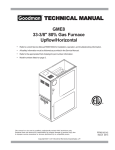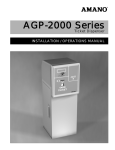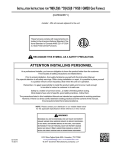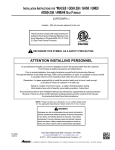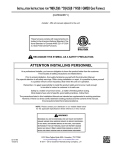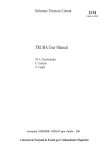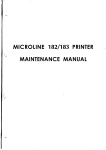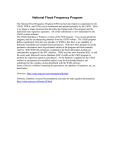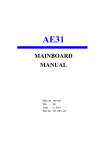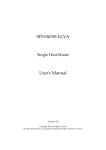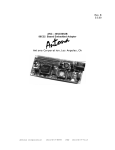Download RWPV™ and DTF™
Transcript
® RWPV and DTF ™ ™ Read/Write/Print/Vault and Dual Ticket Feed Mechanisms SERVICE MANUAL Amano Cincinnati, Inc. reserves the right to make equipment changes and improvements which may not be reflected in this document. Portions of this document may have been updated to include the latest hardware or firmware version, if applicable. We recommend that this document be read in its entirety before any attempt is made to operate the equipment. PROPRIETARY NOTICE This document contains proprietary information and such information may not be reproduced in whole or in part without written permission from Amano Cincinnati, Inc., 140 Harrison Avenue, Roseland, New Jersey, 07068 Table of Contents Chapter 1: INTRODUCTION . . . . . . . . . . . . . . . . . . . . . . . . . . . . . . . . . . . . . . . . 1-1 How to Use this Manual . . . . . . . . . . . . . . . . . . . . . . . . . . . . . . . . . RWPV and DTF Configurations . . . . . . . . . . . . . . . . . . . . . . . . . . . . RWPV and DTF Combinations . . . . . . . . . . . . . . . . . . . . . . . . . RWPV Only . . . . . . . . . . . . . . . . . . . . . . . . . . . . . . . . . . . . . . . . RWPV Replacements . . . . . . . . . . . . . . . . . . . . . . . . . . . . . . . . . Tools Required . . . . . . . . . . . . . . . . . . . . . . . . . . . . . . . . . . . . . . . . RWPV and DTF Components . . . . . . . . . . . . . . . . . . . . . . . . . . . . . . . . . . . . . . . . . . . . . . . . . . . . . . . . . . . . . . . . . . . . . . . . . . . . . . . . . . . . . . . . . . . . . . . . . . . . . . . . . . . . . . . . . . . . . . . . . . . . . . . . . . . . . . . . . . . . . . . . . . . . . . . . . . . . . . . . . . . . . . . . . . . . . . . . 1-1 1-1 1-1 1-2 1-2 1-3 1-4 Chapter 2: REMOVAL AND INSTALLATION . . . . . . . . . . . . . . . . . . . . . . . . . . . . 2-1 Removal . . . . . . . . . . . . . . . . . . . . . . . . . . . . . . . . . . . . . . . . . . . . . . DTF Removal . . . . . . . . . . . . . . . . . . . . . . . . . . . . . . . . . . . . . . . . RWPV Removal . . . . . . . . . . . . . . . . . . . . . . . . . . . . . . . . . . . . . . Installation . . . . . . . . . . . . . . . . . . . . . . . . . . . . . . . . . . . . . . . . . . . . . . . . . . . . . . . . . . . . . . . . . . . . . . . . . . . . . . . . . . . . . . . . . . . . . . . . . . . . . . . . . . . . . . . . . . . . . . . . . . 2-1 2-1 2-2 2-3 Chapter 3: ROUTINE MAINTENANCE . . . . . . . . . . . . . . . . . . . . . . . . . . . . . . . . . 3-1 Routine Maintenance Schedule . . . . . . . . . . . . . . . . . . . . . . . . . . . . . . . . . . . . . . . . . . . . . . . . . 3-1 Clearing a Jammed Ticket . . . . . . . . . . . . . . . . . . . . . . . . . . . . . . . . . . . . . . . . . . . . . . . . . . . . . 3-2 Cleaning the Ticket Path . . . . . . . . . . . . . . . . . . . . . . . . . . . . . . . . . . . . . . . . . . . . . . . . . . . . . . 3-3 Roller Cleaning . . . . . . . . . . . . . . . . . . . . . . . . . . . . . . . . . . . . . . . . . . . . . . . . . . . . . . . . . . 3-4 Mag Head Cleaning . . . . . . . . . . . . . . . . . . . . . . . . . . . . . . . . . . . . . . . . . . . . . . . . . . . . . . 3-5 Print Head Cleaning . . . . . . . . . . . . . . . . . . . . . . . . . . . . . . . . . . . . . . . . . . . . . . . . . . . . . . 3-6 Ribbon Replacement . . . . . . . . . . . . . . . . . . . . . . . . . . . . . . . . . . . . . . . . . . . . . . . . . . . . . . . . . 3-7 Fuse Replacement . . . . . . . . . . . . . . . . . . . . . . . . . . . . . . . . . . . . . . . . . . . . . . . . . . . . . . . . . . 3-8 Belt Replacement . . . . . . . . . . . . . . . . . . . . . . . . . . . . . . . . . . . . . . . . . . . . . . . . . . . . . . . . . . . 3-9 Replacing the Outer Belts- RWPV . . . . . . . . . . . . . . . . . . . . . . . . . . . . . . . . . . . . . . . . . . . . 3-9 Replacing the Inner Belts - RWPV . . . . . . . . . . . . . . . . . . . . . . . . . . . . . . . . . . . . . . . . . . . 3-10 Replacing the DTF Belts . . . . . . . . . . . . . . . . . . . . . . . . . . . . . . . . . . . . . . . . . . . . . . . . . . 3-11 Lubrication . . . . . . . . . . . . . . . . . . . . . . . . . . . . . . . . . . . . . . . . . . . . . . . . . . . . . . . . . . . . . . . 3-12 Cutter (DTF) . . . . . . . . . . . . . . . . . . . . . . . . . . . . . . . . . . . . . . . . . . . . . . . . . . . . . . . . . . . 3-12 Platen Rolling Pin (RWPV) . . . . . . . . . . . . . . . . . . . . . . . . . . . . . . . . . . . . . . . . . . . . . . . . 3-13 Check Connectors . . . . . . . . . . . . . . . . . . . . . . . . . . . . . . . . . . . . . . . . . . . . . . . . . . . . . . . . . . 3-14 Clean Ribbon Cable (DTF) . . . . . . . . . . . . . . . . . . . . . . . . . . . . . . . . . . . . . . . . . . . . . . . . 3-14 RWPV and DTF Service Manual / TABLE OF CONTENTS i Chapter 4: COMPREHENSIVE MAINTENANCE . . . . . . . . . . . . . . . . . . . . . . . . . 4-1 PCB Replacement . . . . . . . . . . . . . . . . . . . . . . . . . . . . . . . . . . . . . . . . . . . . . . . . . . . . . . . . . . . 4-1 Interface PCB . . . . . . . . . . . . . . . . . . . . . . . . . . . . . . . . . . . . . . . . . . . . . . . . . . . . . . . . . . . 4-1 Main PCB . . . . . . . . . . . . . . . . . . . . . . . . . . . . . . . . . . . . . . . . . . . . . . . . . . . . . . . . . . . . . . 4-2 Upgrade Firmware . . . . . . . . . . . . . . . . . . . . . . . . . . . . . . . . . . . . . . . . . . . . . . . . . . . . . . . . . . . 4-3 Replace Tension Roller Spring(s) . . . . . . . . . . . . . . . . . . . . . . . . . . . . . . . . . . . . . . . . . . . . . . . . 4-4 RWPV Mechanism . . . . . . . . . . . . . . . . . . . . . . . . . . . . . . . . . . . . . . . . . . . . . . . . . . . . . . . 4-4 DTF Mechanism . . . . . . . . . . . . . . . . . . . . . . . . . . . . . . . . . . . . . . . . . . . . . . . . . . . . . . . . . 4-5 Replacing Ticket Position Sensors . . . . . . . . . . . . . . . . . . . . . . . . . . . . . . . . . . . . . . . . . . . . . . . 4-6 Sensor Part Numbers . . . . . . . . . . . . . . . . . . . . . . . . . . . . . . . . . . . . . . . . . . . . . . . . . . . . . 4-6 Sensors with Plastic Rivets: . . . . . . . . . . . . . . . . . . . . . . . . . . . . . . . . . . . . . . . . . . . . . . . . 4-7 Sensors Under the Print Assembly . . . . . . . . . . . . . . . . . . . . . . . . . . . . . . . . . . . . . . . . . . . 4-8 Replacing the Ribbon Motor . . . . . . . . . . . . . . . . . . . . . . . . . . . . . . . . . . . . . . . . . . . . . . . . . . . 4-9 Replacing the Read/Write Head . . . . . . . . . . . . . . . . . . . . . . . . . . . . . . . . . . . . . . . . . . . . . . . . 4-10 Replacing the Print Head . . . . . . . . . . . . . . . . . . . . . . . . . . . . . . . . . . . . . . . . . . . . . . . . . . . . . 4-11 Adjust Print Position . . . . . . . . . . . . . . . . . . . . . . . . . . . . . . . . . . . . . . . . . . . . . . . . . . . . . . . . 4-12 Replace Ribbon Guide Assembly . . . . . . . . . . . . . . . . . . . . . . . . . . . . . . . . . . . . . . . . . . . . . . . 4-13 Motor Replacement . . . . . . . . . . . . . . . . . . . . . . . . . . . . . . . . . . . . . . . . . . . . . . . . . . . . . . . . . 4-14 Replacing the Front RWPV Drive Motor . . . . . . . . . . . . . . . . . . . . . . . . . . . . . . . . . . . . . . . 4-14 Replacing the Rear RWPV Drive Motor . . . . . . . . . . . . . . . . . . . . . . . . . . . . . . . . . . . . . . . 4-15 Replacing the Top DTF Drive Motor . . . . . . . . . . . . . . . . . . . . . . . . . . . . . . . . . . . . . . . . . . 4-16 Replacing the Bottom DTF Drive Motor . . . . . . . . . . . . . . . . . . . . . . . . . . . . . . . . . . . . . . . 4-17 Replacing the Vault Solenoid . . . . . . . . . . . . . . . . . . . . . . . . . . . . . . . . . . . . . . . . . . . . . . . . . . 4-18 Appendix A: RMA SHIPPING PROCEDURE . . . . . . . . . . . . . . . . . . . . . . . . . A-1 RMA Procedure . . . . . . . . . . . . . . . . . . . . . . . . . . . . . . . . . . . . . . . . . . . . . . . . . . . . . . . . . . . . A-1 Shipping the RWPV/DTF . . . . . . . . . . . . . . . . . . . . . . . . . . . . . . . . . . . . . . . . . . . . . . . . . . . . . . A-3 Shipping PCBs . . . . . . . . . . . . . . . . . . . . . . . . . . . . . . . . . . . . . . . . . . . . . . . . . . . . . . . . . . . . . A-4 ii RWPV and DTF Service Manual / TABLE OF CONTENTS Chapter 1: INTRODUCTION How to Use this Manual This manual is intended to be a reference source for the person(s) responsible for maintaining and repairing the RWPV (Read/Write/Print/Vault) and DTF (Dual Ticket Feed) mechanisms. The RWPV and DTF are used in a variety of Amano Cincinnati AGP series products in multiple configurations, all of which will be discussed. There are also multiple generations of the devices in the field used during the evolution of these mechanisms which will be covered. Removal and re-installation of the mechanisms in various final products will be discussed. Details of the mechanisms’ functionality are described in the relative manuals for each product. This manual is organized in the following format: Introduction: This Chapter describes the format and layout of this manual, the devices in which the RWPV and DTF are installed, the tools required for service, the various configurations and the location of external components of the mechanisms. Removal and Installation: Chapter 2 describes the removal and installation of the RWPV/DTF mechanisms. Routine Maintenance: Chapter 3 discusses routine maintenance and replacement of consumable commodities. Comprehensive Maintenance: Chapter 4 details the repair, adjustment and replacement of component parts of the RWPV and DTF. Appendix A: This appendix includes instructions for obtaining an RMA (Returned Materials Authorization) which is required when returning equipment for repair. A blank RMA form and shipping instructions are included. RWPV and DTF Configurations An RWPV mechanism can be used alone, or in combination with a DTF mechanism. A DTF mechanism can never be used alone, and is always used in combination with an RWPV. The use of the RWPV/DTF mechanisms are determined by the product application. RWPV and DTF Combinations The following products utilize the RWPV and DTF mechanisms in combination: • AGP-2000 series Ticket Dispenser. • AGP-4300 series Central Pay ExpressParc™. • AGP-4400 series Exit Pay ExpressParc™. RWPV and DTF Service Manual / INTRODUCTION 1-1 RWPV Only The following products incorporate the RWPV only (without the DTF mechanism). • AGP-5600 series Validator. • AGP-6000 series Lag Time Reader. • AGP-7000 series Pay Station. RWPV Replacements An RWPV and/or DTF can be ordered from the factory as replacement parts or can be removed from one product and installed in another. There are two versions of the RWPV/DTF combination which are not interchangeable. • U14032: This is the replacement RWPV/DTF for all products except ExpressParc™. The mechanism can be converted from one product configuration to another by repositioning the print head (see Chapter 3) and re-programming the set-up parameters (see the individual product manuals). The DTF can be removed for RWPV use in other products as well. • U14032-07: This is the replacement RWPV/DTF for ExpressParc™ only. The on-board programming is unique to ExpressParc™ and cannot be altered. There are two versions of the RWPV which are interchangeable. • U14032-01: This RWPV is used in the AGP-5600 and AGP-7000 but can be used in the AGP-6000 if configured properly. • U14032-02: This RWPV is used in the AGP-6000 but can be used in the AGP-5600 and AGP-7000 if configured properly. 1-2 RWPV and DTF Service Manuall / INTRODUCTION Tools Required The following is a list of tools required for servicing the RWPV/DTF assemblies. They should be part of the field tool kit for all service personnel. Socket Wrenches 1/2” 9/16” 5.5 mm 7 mm 10 mm Nut Drivers 1.5 mm Allen Head Wrenches .035” 1.5 mm 2 mm Screw Drivers small flat head #1 Philips #2 Philips Needle Nose Pliers PLCC I.C. (Integrated Circuit) Extractor Wire Cutters Digital Multi-Meter Rubber Cleaner/Conditioner MG Chemical's ® "408A Rubber Renue" or RawnT M Company’s “Re-Grip” Cotton Swabs RWPV and DTF Service Manual / INTRODUCTION 1-3 RWPV and DTF Components The following diagram illustrates the location of major RWPV and DTF external components. Figure 1-1: RWPV and DTF Assemblies Components and 1. Lithium Battery 2. Card/Ticket Throat 3. Ribbon Motor 4. Top Fuse 5. Bottom Fuse 6. Main Logic PCB 7. Interface PCB 8. Drive Gears and Belts 9. Printer 10. Printer Release Latch 11. RWPV front motor 12. RWPV rear motor 13. DTF top motor 14. DTF bottom motor 1-4 Descriptions 3.6 V 1.9 AH Lithium Battery on rear of Main PCB Accepts cards and tickets for calculation and payment Drives the printer ribbon 5 Amp GMCV-5A 125 Volt Slo Blow 1 Amp GDC-1A 250 Volt Controls all functions of the RWPV/DTF Controls communications to and from RWPV/DTF Drives the RWPV/DTF mechanisms Prints transaction data on tickets and cards Allows access for removal of jammed tickets/cards Motor #4: Manipulates ticket for writing Motor #3: Feeds ticket to motor #4 Motor #2: Delivers ticket to RWPV Motor #1: Loads tickets into DTF RWPV and DTF Service Manuall / INTRODUCTION Chapter 2: REMOVAL AND INSTALLATION Removal Some service procedures require the removal of the RWPV/DTF. When installed with a DTF mechanism, the DTF must be removed prior to the RWPV. This procedure applies universally to all devices using an RWPV. The only differences are the specific mounting holes used to secure the RWPV/DTF to the device chassis. Note: Be sure to power down the system prior to removal. DTF Removal 1. Power down the system if you have not already done so. 2. Refer to Figure 2-1 to locate the DTF wiring. 3. Disconnect the wires to the ticket cutter solenoid from terminals J2 and J3 in the lower right corner of the RWPV Interface PCB. 4. Disconnect the Ribbon Cable running between P1 on the DTF’s Optic Sensor Interface board and P16 on the RWPV Interface. Figure 2-1: Disconnect the DTF Wiring 5. Loosen the mounting screw(s) securing the back of the DTF to the device chassis. 6. Slide the DTF towards the back of the chassis until it clears the RWPV and lift out. Figure 2-2: Remove the DTF 7. Reverse these steps to re-install. RWPV and DTF Service Manual / REMOVAL AND INSTALLATION 2-1 RWPV Removal 1. Power down the system if you have not already done so. 2. Remove the DTF (if present). 3. Refer to Figure 2-3. Reach behind the unit to label and disconnect any Communications Cables from the Com ports on the Interface Board. 4. Disconnect the Power Connector from the Interface PCB. Figure 2-3: Disconnect the Power and Communication Cables 5. Loosen (but do not remove) the Mounting Screw(s) located at the rear of the unit holding the RWPV in place. 6. Slide the RWPV to the rear and lift up. Figure 2-4: Remove the RWPV 7. Reverse these steps to re-install the RWPV. 2-2 RWPV and DTF Service Manual / REMOVAL AND INSTALLATION Installation When installing an RWPV/DTF into a product, it is important to be sure the configuration settings in the SETUP/MODEL menu (see the individual product programming manual) are set correctly for the product. See Chapter 4 for instructions on adjusting the Print Head position. Following is a description of the Model settings: • T/D: Sets this device as a Ticket Dispenser. • L/R: Sets this device as a Lagtime Reader. • DUAL: Set to yes when a DTF mechanism is installed. • MAG TYPE: Defines the Magnet Encoding Type. This should be APS (Amano Parking System) for all products. • AEE SYSTEM: Amano Electronics Europe should be NO for all products. • COMMS: Sets the Comm Type to either Amano Parking System or Global Parking Products communication parameters. RWPV and DTF Service Manual / REMOVAL AND INSTALLATION 2-3 2-4 RWPV and DTF Service Manual / REMOVAL AND INSTALLATION Chapter 3: ROUTINE MAINTENANCE This chapter covers routine replacement of consumable items, parts subject to wear and recovering from ticket jams. Routine Maintenance Schedule The following chart should be used as a guide for performing the listed maintenance procedures. *The mylar guides must be replaced by the factory. It is recommended that the unit be returned to the factory after one million tickets have been processed for service of all indicated parts. Refer to Appendix A for RMA information. **The lithium battery has a five year shelf life if it is connected to the RWPV while in storage. If the RWPV is in service and powered up, the battery will last ten years. The shelf life of the battery by itself (not connected) is ten years. RWPV and DTF Service Manual / ROUTINE MAINTENANCE 3- 1 Clearing a Jammed Ticket This procedure can be performed by reaching over the top of the mechanism. No removal is necessary. 1. Locate the jammed ticket within the ticket transport. Make a note of the condition of the ticket (bent, torn, etc.), the sensor(s) at the postion the jam occured (refer to Figure 3-2 for sensor numbers) and any blockage or damage to the channel. This will help to indicate the cause of the jam (dirty or damaged sensor or channel obstruction) to aid in diagnostics. Note: If the ticket is undamaged, try resetting the RWPV to allow it to clear the ticket itself. This is accomplished by cycling the power. If this is not successful, proceed as follows: 2. Turn the power off. 3. Refer to Figure 3-1 below to locate the Printer Release Latches on both sides of the printer. Pull both of the latches forward to release the printer. 4. Tilt the printer assembly up and back . 5. Locate the plastic motor pulleys on the left side of the RWPV mechanism . Rotate each motor pulley to move the ticket towards the front or rear of the mechanism. Caution: Rotate motor drive pulleys only. Do not rotate driven pulleys. 6. Grasp the jammed ticket and remove it from the mechanism. 7. Tilt the printer assembly back down and reset the latches. 8. If the jam is in the DTF mechanism (if applicable), follow the same procedure, rotating only the motor pulleys to move the tickets. Figure 3-1: Clearing a Ticket Jam 3- 2 RWPV and DTF Service Manual / ROUTINE MAINTENANCE Cleaning the Ticket Path It is important to keep the Ticket Path clean and clear of dust, dirt and magnetic residue generated by handling tickets. Use a can of compressed air (GC Electronics p/n 10-8475 Airjet II is recommended: it is anti-static and leaves no residue) or a vacuum cleaner to clear the channel whenever dust is visible. This is particularly important around the position sensors. Dirt around a sensor can be read as a ticket when none is present and cause an intermittent error. Refer to figure 3-2 for sensor positions. The sensor positions are referred to in the Diagnostics Routine. Figure 3-2: Sensor Positions Pull back on the Printer Release Latches and tilt the printer assembly up (see Figure 3-4) to clean the portion of the Ticket Path under the Print Head. Whenever the ticket path is cleaned, we recommend also cleaning the rollers, mag head and print head. Refer to the following sections for details. RWPV and DTF Service Manual / ROUTINE MAINTENANCE 3- 3 Roller Cleaning If any of the rubber rollers require cleaning, do not use alcohol. Alcohol dries out rubber and will cause deterioration of the rollers. Use a cleaner specifically formulated for rubber, such as MG Chemical's® "408A Rubber Renue" or Rawn TM Company’s “Re-Grip” and a cotton swab. Figure 3-3: Cleaning the Rollers The Roller surfaces should never be touched by hand or with any sharp instrument; only touch the sides of the Rollers. Motor driven Rollers can be turned by rotating the motor pulleys (see the Clearing a Jammed Ticket section). Turning these Rollers can be more easily facilitated by running the motor tests in the Diagnostics routine. Continue to the next section, Mag Head Cleaning. 3- 4 RWPV and DTF Service Manual / ROUTINE MAINTENANCE Mag Head Cleaning Whenever the Ticket Path is cleaned or every 40,000 tickets, the magnetic Read/Write head should be cleaned to remove any magnetic residue. Figure 3-4: Cleaning the Read/Write Head 1. Tilt the Printer Assembly up if you have not already done so. 2. Use a cotton swab moistened with any commercially available tape head cleaner. 3. Gently wipe the Read/Write head in the longitudinal direction as indicated by the arrows in the above figure. Never wipe across the head. 4. Use a dry swab in the same direction to remove excess cleaner. Make sure no cotton fibers remain. 5. The head should be completely dry before using the RWPV. Note: After cleaning, make sure the head is not jammed above the bracket. It should extend below the bracket and float freely. Continue to Print Head Cleaning described in the following section. RWPV and DTF Service Manual / ROUTINE MAINTENANCE 3- 5 Print Head Cleaning Whenever the Ticket Path is cleaned or every 40,000 tickets, the Print Head should be cleaned. Figure 3-5: Cleaning the Print Head 1. Tilt the Printer Assembly up if you have not already done so. 2. Remove the ribbon as described on the following page. 3. Gently clean the ink from the Print Head with a cotton swab moistened with isopropyl alcohol. Allow the head to air dry before re-installing the ribbon. Note: Make sure there are no cotton fibers stuck in the head. 4. Re-install the ribbon. 5. Tilt the Printer Assembly back down and reset the latches. 3- 6 RWPV and DTF Service Manual / ROUTINE MAINTENANCE Ribbon Replacement The ribbon should be replaced whenever the print quality degrades (becomes too light). The average life is approximately 50,000 tickets. To remove the old ribbon cartridge: This procedure can be performed by reaching over the top of the mechanism. No removal is necessary. 1. Refer to Figure 3-6 below to locate the ribbon cartridge and white nylon retainer tabs securing the cartridge in place. 2. Pull back on the Printer Release Latches to tilt the printer up and back. 3. Pull up on the Top Retainer Tab across the top of the ribbon cartridge to release it. 4. Hold the Top Retainer Tab up while pulling the cartridge away from the printer. Figure 3-6: Replacing the Ribbon Cartridge To install a new ribbon cartridge: 1. Pull back on the Printer Release Latches to tilt the printer up and back if you have not already done so. 2. Turn the ribbon advance knob on the new cartridge so that the ribbon is taut. 3. Position the Ribbon Cartridge so that the adjustment knob is towards you. 4. Snap the Ribbon Cartridge into place passing the ribbon under the print head. 5. Make sure the cartridge is fully seated on both sides. Push down on the Top Retainer Tab to make sure it is securely fastened over the top of the cartridge. 6. Make sure the ribbon passes under the print head and is not twisted. Turn the adjustment knob on the front of the cartridge to tighten and straighten the ribbon. 7. When finished, tilt the printer assembly back into place and secure it with the release latches. Note: Use only an RWPV ribbon (Amano part number CE-316250). This ribbon contains an ink tank which will assure long ribbon life (approximately 50,000 tickets). Generic ribbons may leak ink onto the platten, gum up the print head and not couple with the mechanism properly. Use of other than an Amano ribbon will void the warranty. RWPV and DTF Service Manual / ROUTINE MAINTENANCE 3- 7 Fuse Replacement There are two fuses (see Figure 3-7) on the Interface PCB. If the RWPV is installed in a Pay Station, the fuses can be accessed by removing the front cover plate, although RWPV removal is recommended. Figure 3-7: Interface Board Prior to replacing a fuse, examine the board for any burnt traces or components. If the board appears damaged do not replace a fuse; the board must be replaced. Also check for correct cable connections. Warning: The RWPV has an on-board battery on the Main Board. Power is present at all times, even when AC power is disconnected. Use only a plastic screwdriver to remove fuses, prying gently up on the glass towards the end of the fuse to avoid short circuits and damage to the fuse clips. Some boards have a plastic protector around the top fuse to help protect against short circuits. 1. Power down the host equipment. 2. Access the RWPV. 3. Use a plastic screwdriver to pry one end of the fuse out of the fuse holder and then lift the fuse out. 4. Squeeze the fuse clips slightly together prior to installing a new fuse to be sure the fuse is firmly retained. 5. Be sure to replace each fuse with a new one of the same type and rating. À Top Fuse: 5 Amp GMCV-5A 125 Volt Slo Blow P/N: 032982 Á Bottom Fuse: 1 Amp GDC-1A 250 Volt P/N: 032981 3- 8 RWPV and DTF Service Manual / ROUTINE MAINTENANCE Belt Replacement Belts that are stretched and loosely fitting, are cracked or have worn or missing teeth must be replaced. Depending on the belts needing replacement, it may be necessary to remove the RWPV/DTF from the system chassis. Removal of the Pay Station RWPV is always required. Caution: Always power down the system prior to replacing belts. Replacing the Outer Belts- RWPV If one of the small outer belts require replacement, the pulley for that belt must be removed. • Rear small belt: • Front small belt: p/n 033177-070 p/n 033177-080 Figure 3-8: Replacing the Outer Belts 1. Loosen the allen head set screw (1.5 mm Allen wrench required) securing the Pulley. Slide the Pulley off the shaft while holding the belt. 2. Remove the belt. 3. Place the new belt over the remaining Pulley and re-install the loose Pulley, with the belt in place. 4. Sight along the pulleys, making sure they line up with each other. The belt should be straight, not tilted. 5. Firmly tighten the set screw. RWPV and DTF Service Manual / ROUTINE MAINTENANCE 3- 9 Replacing the Inner Belts - RWPV • Rear inner belt: p/n 033177-110 • Front inner belt: p/n 033177-144 1. First remove the appropriate outer belt(s) as described previously. Figure 3-9: Replacing the Inner Belts 2. Loosen the pivot and adjusting screws, then pivot the motor mounting plate up to release tension on the belt. 3. Install the new belt. 4. Press lightly down on the motor pulley to remove any slack from the belt (do not press hard; just enough so the belt is snug). Tighten the adjusting screw and then tighten the pivot screw. When the belt is properly tensioned, a .5 to 1.0 LB (.23 to .45 kg) force applied to the center of the belt will result in a .2" (.5 cm) deflection. 5. Re-install the outer belt(s). Note: The front belt adjustment is critical and should be adjusted every 200,000 tickets. If the belt is too tight, you can hear the motor straining when a credit card is read. If it is too loose, there will be bad credit card reads and a thumping may be heard as the belt jumps on the pulleys. 3 - 10 RWPV and DTF Service Manual / ROUTINE MAINTENANCE Replacing the DTF Belts • Top belt: • Bottom belt: p/n 033177-110 p/n 033177-090 Figure 3-10: Replacing the DTF Belts 1. Loosen the Pivot and Adjusting Screws and pivot the motor mounting plate up to release tension on the belt. 2. Install the new belt. 3. Press lightly down on the motor pulley to remove any slack from the belt (do not press hard; just enough so the belt is snug). Tighten the adjusting screw and then tighten the pivot screw. When the belt is properly tensioned, a .5 to 1.0 LB (.23 to .45 kg) force applied to the center of the belt will result in a .2" (.5 cm) deflection. RWPV and DTF Service Manual / ROUTINE MAINTENANCE 3 - 11 Lubrication Cutter (DTF) Periodically the cutter mechanism in the DTF requires lubrication. Routine lubrication is specified every six months. Examine the channels in the Cutter Frame in which the Knife Bar and Cutter Bar move. If the lubricant appears dry or contaminated or if the bars are sticking, cleaning and lubrication is indicated. The recommended grease is Dow Corning Molykote, grade YM-102 (Amano p/n YM-102000). Figure 3-11: Lubricating the DTF Cutter 1. Clean off as much of the old lubricant as possible using a clean rag or cotton swab. Do not leave any fibers in the channels. 2. Using a toothpick or small screwdriver, apply a thin coating of grease to the portion of the Knife Bar channels (on both sides of the mechanism) above the bar. 3. From the outside edges of the Knife Bar, lift and hold the bar in its up position. Apply a thin coating of grease to the portion of the channels below the bar. 4. Manually raise and lower the bar a couple of times to distribute the grease. 5. Press the Cutter Bar as far as possible towards one side of the frame. 6. Put a very thin coating of grease on the top and bottom of the bar where it extends beyond the channel. 7. Press the Cutter Bar to the other side of the frame and coat the top and bottom of the other side of the bar. 3 - 12 RWPV and DTF Service Manual / ROUTINE MAINTENANCE Platen Rolling Pin (RWPV) The platen rolling pin should be lubricated at six month intervals, or whenever the cutter mechanism is lubricated. Lubricate the pin where it slides in the platen lever. The recommended grease is Dow Corning Molykote, grade YM-102 (Amano p/n YM102000). Figure 3-12: Lubricating the Platen Rolling Pin 1. Press and hold the Platen Lever towards the back of the RWPV to rotate the platen and leave clearance above the Pin to apply grease. 2. Apply a small amount of grease to both sides of the slot above the Pin using a toothpick or similar implement. 3. Move the lever back and forth several times to distribute the grease. RWPV and DTF Service Manual / ROUTINE MAINTENANCE 3 - 13 Check Connectors At least once a year, check all the connectors on the boards to be sure that they are firmly seated. Clean Ribbon Cable (DTF) At least once a year, clean the contacts on the ribbon cable running between the Optic Sensor Interface PCB on the DTF and the Interface PCB on the RWPV. Figure 3-13: Cleaning the Ribbon Cable 1. Gently pull the Ribbon Cable from the connector P16 on the RWPV Interface PCB. 2. Clean the contacts on both sides of the cable with a cotton swab moistened with any commercial contact cleaner or isopropyl alcohol. 3. Line the cable up with the socket and gently re-insert it. Push until it is fully seated. 4. Repeat this procedure for the other side of the cable going to P1 on the DTF Optic Sensor Interface PCB. Note: Be careful not to kink or crease the cable. 3 - 14 RWPV and DTF Service Manual / ROUTINE MAINTENANCE Chapter 4: COMPREHENSIVE MAINTENANCE This chapter covers field repair, replacement and adjustment of RWPV components. These procedures require the attention of Amano Cincinnati qualfied technicians. PCB Replacement Except for fuse replacement or a Firmware upgrade, the PCBs cannot be serviced in the field. Replace the defective PCB and send the defective assembly back to the factory in an anti-static bag using appropriate shipping protection. Refer to Appendix A for RMA information. Note: Prior to returning a PCB to the factory for repair, document the nature of the problem (symptoms) as completely as possible and include this description with the RMA. This will greatly aid the technicians in troubleshooting. Depending upon the device in which the RWPV is installed, it may be necessary to remove the unit prior to replacing the circuit boards. Figure 4-1: PC Boards Interface PCB The outer board (p/n U13914) is the Interface PCB. Refer to Figure 4-1 to identify the Interface PCB and its connetors. To replace: 1. Power down the host device. 2. Disconnect the Power Connector from the Interface PCB. 3. Label (if not already labeled) and remove the communcation cable(s) from the Main PCB. 4. Remove the RWPV (if necessary). 5. Label each cable (if not already labeled) with the number of its matching connector (P1, P2, etc) or sensor number silkscreened on the board. 6. Disconnect each cable. 7. Remove the Mounting Screw located in the center of the PCB near the sensor connectors with a Philips screwdriver. 8. Gently ease the board straight out, detaching the connector pins on the back from the mounting connector on the Main board. 9. Reverse this procedure to install the replacement PCB. RWPV and DTF Service Manual / COMPREHENSIVE MAINTENANCE 4- 1 Main PCB The bottom board (p/n U13913-01) is the Main PCB. Figure 4-2: Removing the Main PCB Caution: Do not place the Main PCB on any metal surface. The board contains a battery and metal contact could cause a short circuit. Always use standard static protection precautions when handling the PCBs. 1. Remove the Interface PCB as described above. (If only the Main PCB is being replaced, it is not necessary to completely disconnect the Interface Board. Just disconnect the MOT 3 and MOT 4 cables in the lower left corner and pivot the board gently over the top of the assembly). 2. Disconnect the P1 cable at the top center of the Main board. 3. Remove the standoff in the center of the board. 4. Remove the four Philips head mounting screws and remove the board. 5. Install the replacement board by reversing this procedure. 4- 2 RWPV and DTF Service Manual / COMPREHENSIVE MAINTENANCE Upgrade Firmware The firmware chip is on the Main PCB in socket U24. An LCC extractor (available at electronics stores) will be required to complete this process. Caution: Observe standard anti-static precautions for this procedure. Figure 4-3: Upgrading the Firmware 1. Remove the Interface PCB. 2. Carefully remove the firmware chip with the extractor. 3. Insert the new firmware chip making sure it is firmly and evenly seated. Note: The chip can only be inserted one way. Make sure to align the angled corner of the chip with the angled corner of the socket. 4. After replacing the firmware, you must clear the RAM. Using needle nose pliers, carefully pull the negative battery lead from its socket. Caution: Use extreme care to make sure neither the pliers nor the battery lead contacts any traces on the circuit board. 5. Wait at least 5 seconds and carefully re-insert the lead into its socket. 6. Replace the Interface PCB. Note: When installing firmware version 34.2 and later into a system with an older DTF mechanism (see the following figure), set the Ticket Offset (see AGP-2000 or ExpressParc programming manuals) under the ISSUE menu to 005. With the newer DTF, the offset should be 035. Figure 4-4: DTF Brakcet Comparison RWPV and DTF Service Manual / COMPREHENSIVE MAINTENANCE 4- 3 Replace Tension Roller Spring(s) RWPV Mechanism Refer to Figure 4-5 to locate the two RWPV Tension Roller Springs. If a spring (p/n IR-310900) is bent or broken it will have to be replaced. Figure 4-5: Replacing an RWPV Tension Roller Spring To replace a Tension Roller Spring: 1. Remove the Mounting Screw securing the Tension Roller Assembly to the RWPV chassis and set it aside. 2. Slide the assembly away from the mounting hole, clearing the cutout in the chassis. 3. Tilt the assembly up and lift it out of the chassis. 4. Gently pry the Roller Axle out of the spring assembly. 5. Remove the defective spring from the mounting bracket by removing the two Mounting Screws. 6. Attach the new spring to the bracket, tightening the screws firmly. 7. Gently press the Roller Axle into the new spring. Be careful not to bend the spring. Make sure the Axle is fully seated and that the Roller is centered on the axle. 8. Replace the assembly in the chassis by reversing steps 1 to 3. Tighten the screw securely. 4- 4 RWPV and DTF Service Manual / COMPREHENSIVE MAINTENANCE DTF Mechanism Refer to the following figure to locate the DTF field replaceable Tension Roller Springs. If a spring is bent or broken, it will have to be replaced. With the exception of the top rear spring (red), replace the springs with p/n IR-310900. Figure 4-6: Replacing DTF Tension Roller Springs To replace a rear Tension Roller Spring: 1. Remove the two screws holding the spring to the bracket. 2. Gently pry the roller axle out of the spring. 3. Gently press the axle into the new spring. Be careful not to bend the spring. Make sure the axle is fully seated and that the roller is centered on the axle. 4. Remount the assembly to the bracket and tighten the two screws. Note: The top spring (p/n IM-012500) has two washers (p/n 012539) mounted between the spring and the bracket. To replace the top center Tension Roller Spring: 1. Remove the Mounting Screw holding the top tension bracket to the chassis. 2. Slide the bracket away from and towards the back of the chassis to clear the mounting slots in the chassis and remove the bracket. 3. Gently pry the roller axle out of the spring assembly. 4. Remove the defective spring from the mounting bracket by removing the two mounting screws. 5. Attach the new spring to the bracket, tightening the screws firmly. 6. Gently press the roller axle into the new spring. 7. Replace the assembly in the chassis by reversing steps 1 and 2. Tighten the screw securely. RWPV and DTF Service Manual / COMPREHENSIVE MAINTENANCE 4- 5 Replacing Ticket Position Sensors There are eleven ticket position sensors along the ticket path (five in the RWPV and six in the DTF) that detect the presence of a ticket. All of the sensors except the two under the print assembly are single piece sensors held in place by plastic rivets. The two sensors under the print assembly are two piece sensors held in place by a screw and a plastic rivet. Sensor Part Numbers Other than split vs whole sensors, the assemblies are differentiated by the length of the cable. The Sensors are numbered from the back of the DTF mechanism to the front of the RWPV (throat). These numbers coorespond to the Sensor test in the Diagnostics Mode. Figure 4-7: Sensor Positions 4- 6 Sensor Position Part Number Split/Whole Rivet Part # (1-6) DTF U13920-06 Whole RTB-306500 (7) RWPV Rear (8) RWPV Middle (9) Back of Head (10) Front of Head (11) Throat U13920-01 U13920-02 U13920-03 U13920-04 U13920-05 Whole Whole Split Split Whole RTB-306500 RTB-306500 RTB-306500 RTB-306500 RTB-308000 RWPV and DTF Service Manual / COMPREHENSIVE MAINTENANCE Sensors with Plastic Rivets: Figure 4-8: Removing a Position Sensor 1. Gently pull the Locking Pin out of the fastener. 2. Press the Retaining Tabs together and pull the fastener out of the chassis and sensor mounting hole. 3. Repeat for the other fastener. 4. Slide the Sensor out of the chassis. It may be necessary to gently rock the Sensor to dislodge the bottom half of the Sensor from the mylar shield. Caution: Be careful not to nick or deform the mylar shield which runs the length of the ticket path (see the following figure) when removing or installing the sensors. A damaged mylar shield will result in ticket jams and bad sensor reads. If the shield is damaged, the RWPV or DTF will have to be returned to the factory for repair. 5. Carefully cut the ty-wrap holding the sensor wires together. 6. Separate the defective sensor cable from the rest of the cable harness and unplug the connector from the Interface PCB. 7. Plug the new Sensor into the Interface PCB. 8. Reverse the above procedure to install the new Sensor. Note: The green wire on each sensor should always be on the top half of the sensor when installed. In the DTF, the sensors that are not on top should be mounted with the green wires facing the center of the mechanism. Be careful feeding the fastener into place and be sure it is firmly seated before inserting the Locking Pin. 9. Install a new ty-wrap to hold the sensor cables together. Figure 4-9: Mylar Shield RWPV and DTF Service Manual / COMPREHENSIVE MAINTENANCE 4- 7 Sensors Under the Print Assembly The two sensors under the Print Assembly are split into two halves to allow the Print head to pivot up. The top half of each sensor is held in place with a plastic rivet and the bottom half by a screw to allow for adjustment. New RWPV units are being shipped with clear plastic versions of these two sensors. The top (lense) half of the sensor has exposed clear portions coated with gold or red metallic ink. It is very important that this coating not be scratched or damaged or read errors will occur. If the coating is scratched, recoat the surfaces indicated with ink from a sensor ink pen (Sanford® Corp. p/n 76715), available from any office supply house. Do not get ink on the lens surface. Figure 4-10: Coated Sensor Surfaces Note: Be careful not to damage the mylar shield covering the bottom half of the sensors. If the shield is damaged, the RWPV will have to be sent back for service. Figure 4-11: Split Sensors 1. Remove the riveted Top Half of the sensor as described above. 2. Remove the Bottom Half by removing the screw. It may be necessary to gently rock the sensor to dislodge it from the Mylar Shield. 3. Reverse the procedure for installation (green wire on the top half of the sensor). Leave the screw on the Bottom Half slightly loose to allow for adjustment. 4. Adjust the Bottom Half of the sensor to protrude .01” (.254mm) above the base and tighten the mounting screw. Gently press down on the Mylar Shield around the sensor so that the shield sticks to the sensor and the ticket path. You need to form a good seal so that dust doesn’t get under the shield and block the sensor. 4- 8 RWPV and DTF Service Manual / COMPREHENSIVE MAINTENANCE Replacing the Ribbon Motor Locate the Ribbon Motor (p/n U13916) on top of the Print Assembly. Figure 4-12: Replace the Ribbon Motor 1. Remove the ribbon (see Chapter 3). 2. Remove the two screws and lock washers securing the Ribbon Motor to the mounting plate. Be careful not to lose the two nylon spacers around the screws that are between the bottom of the motor housing and the mounting plate. 3. Ease the motor away from the mounting plate. 4. Carefully cut the ty-wrap holding the motor cable and all the sensor cables. 5. Separate the motor cable from the harness and unplug the cable from the ribbon motor connector on the top edge of the Interface PCB. 6. Mount the new motor to the mounting plate. Be sure to replace the nylon spacers. Tighten the mounting screws. 7. Plug the new motor cable into the ribbon cable connector on the interface PCB. 8. Install a new ty-wrap to hold the sensor wire harness together. RWPV and DTF Service Manual / COMPREHENSIVE MAINTENANCE 4- 9 Replacing the Read/Write Head When replacing the Read/Write Head (p/n U14165), be careful not to chip or scrape the read/write surface. Doing so will destroy the head. Older RWPV’s may have a fixed position head. These should be replaced with the newer floating heads which require no position adjustment when installed. The Ribbon Motor should be removed prior to performing this procedure to allow sufficient clearance to remove the head (see previous section). Figure 4-13: Replacing the Read/Write Head 1. Remove the Ribbon Motor if you have not already done so. 2. If there is a ty-wrap securing the head wiring to the motor, cut the ty-wrap. 3. Remove the two Mounting Screws securing the Head Assembly to the frame. 4. Angle up the front of the Head Assembly and guide it out of the frame. 5. Disconnect the head cable from the top center connector “P1” on the Main PCB. 6. Reverse this procedure to install the new Head. Be very careful not to scratch the surface of the head. The top of the Head Assembly should be even with the frame when the screws are tightened. Note: Once assembled, the Read/Write Head should extend below the surface of the printer assembly bracket, retract flush with or above the surface when pushed (carefully) and float freely. It should lightly contact the blue roller when the head assembly is latched. 4 - 10 RWPV and DTF Service Manual / COMPREHENSIVE MAINTENANCE Replacing the Print Head Figure 4-14: Removing the Print Head 1. Remove the Ribbon Cartridge (See Chapter 3). 2. Pull forward on the printer release latches and tilt the printer assembly back. 3. Remove the retaining screw (in some cases a plastic rivet) securing the Print Head ribbon cable. 4. Lift up on the Retaining Clamp securing the ribbon cable in connector “P5” on the Interface PCB. 5. Gently remove the cable from the connector. 6. Squeeze the release tabs securing the Print Head and slide the unit outward. Gently manipulate the head until the Retaining Slots clear the Release Tabs and pull the unit clear. 7. Feed the ribbon cable through the feed thru slot. 8. Reverse this procedure to reinstall. Be careful handling the ribbon cable so that it does not catch or tear. Make sure the cable is firmly seated in the connector before pushing down on the retaining clamp. RWPV and DTF Service Manual / COMPREHENSIVE MAINTENANCE 4 - 11 Adjust Print Position While adjustment of the printing position is not required as routine maintenance, it may be necessary when a new RWPV is being installed for a particular application. When the RWPV is installed in a Ticket Dispenser the ticket is printed along the bottom edge. When installed in a Lag Time Reader, ExpressParc™ unit, Validator or Pay Station, the printing is one line up from the bottom edge of the ticket. To adjust the print position, the Carriage Bracket containing the entire Print Head Assembly is moved to either the center or the outside of the mechanism, depending on the application. This is facilitated by removing four screws retaining the bracket. The left illustration in the following figure shows the Print Head Assembly in the outside position, set to print on the bottom of the ticket for a Ticket Dispenser configuration. The right illustration exhibits the Print Head Assembly in the inside position, set to print on the second line of the ticket for any other configuration. Figure 4-15: Changing Product Configuration To convert the RWPV configuration, proceed as follows. 1. Remove the front (shown) and rear screws securing the Print Head Assembly to the Bracket. 2. Slide the Print Head Assembly towards the desired position of the mechanism, lining up the indicated holes in the Assembly with the threaded holes in the Bracket. 3. Re-install the four retaining screws. 4 - 12 RWPV and DTF Service Manual / COMPREHENSIVE MAINTENANCE Replace Ribbon Guide Assembly If the mylar on the Ribbon Guide becomes damaged, the assembly will have to be replaced. A damaged mylar strip will result in ticket jams and possible Print Head and ribbon damage. Figure 4-16: Replacing the Ribbon Guide 1. Remove the two Mounting Screws retaining the Ribbon Guide. 2. Install the new guide and loosley snug the mouting screws. 3. Press down on the Ribbon Guide so that it rests flush with the side rail. 4. Tighten the screws securely. RWPV and DTF Service Manual / COMPREHENSIVE MAINTENANCE 4 - 13 Motor Replacement Replacing the Front RWPV Drive Motor The Front Drive Motor/Dot Clock PCB is replaced as an assembly. Figure 4-17: Replacing the Front Drive MotorAssembly 1. Unplug the motor power cable from the "MOT4" (P19) connector on the Interface PCB. 2. Cut the ty-wraps holding the motor cable and the sensor cables together as wire harnesses. 3. Unplug the cable from the DOT Clock PCB to the sensor section [Sensor “13” (P8)] of the Interface PCB. 4. Slide the drive belt off of the motor pulley. (The belt does not have to be removed; just let it hang loose.) 5. Remove the Motor Plate Mounting Screws and slide the assembly and attached cables out of the chassis. 6. Remove the two mounting screws holding the motor to the Motor Mounting Plate and remove the motor. 7. Mount the new motor on the mounting plate. 8. Feed the cables through and attach the mounting plate to the chassis. Snug the mounting screws finger tight. 9. Re-attach the drive belt. Press lightly down on the motor pulley to remove any slack from the belt (do not press hard; just enough so the belt is snug). Tighten the adjusting screw and then tighten the pivot screw. When the belt is properly tensioned, a .5 to 1.0 LB (.23 to .45 kg) force applied to the center of the belt will result in a .2" (.5 cm) deflection. 10. Plug the cables into their respective connectors on the Interface PCB. Install new ty-wraps to hold the harnesses together. 4 - 14 RWPV and DTF Service Manual / COMPREHENSIVE MAINTENANCE Replacing the Rear RWPV Drive Motor Figure 4-18: Replacing the Rear Drive Motor 1. Unplug the rear motor power cable from the "MOT3" (P18) connector on the interface board. 2. Cut the ty-wraps holding the two motor cables together. 3. Slide the drive belt off the motor pulley (the belt does not have to be removed). 4. Remove the Motor Plate Mounting Screws and slide the assembly and attached cable out of the chassis. 5. Remove the two mounting screws securing the motor to the Motor Mounting Plate. Remove the motor. 6. Mount the new motor on the mounting plate using the two mounting screws previously removed. 7. Feed the cables through the chassis. Attach the mounting plate to the chassis using the motor plate mounting screws. Snug the mounting screws finger tight. 8. Re-attach the drive belt. Press lightly down on the motor pulley to remove any slack from the belt (do not press hard; just enough so the belt is snug). Tighten the adjusting screw and then tighten the pivot screw. When the belt is properly tensioned, a .5 to 1.0 LB (.23 to .45 kg) force applied to the center of the belt will result in a .2" (.5 cm) deflection. 9. Plug the power cable into the Interface PCB. Install new ty-wraps to hold the cable together. RWPV and DTF Service Manual / COMPREHENSIVE MAINTENANCE 4 - 15 Replacing the Top DTF Drive Motor The Top Drive Motor/Dot Clock PCB is replaced as an assembly. Figure 4-19: Replacing the Top DTF Drive Motor 1. Unplug the motor power cable from the "MOTOR 2" (P10) connector on the optic sensor Interface PCB. 2. Cut the ty-wrap holding the motor cable to the Interface PCB mounting standoff. 3. Unplug the cable running from the DOT Clock PCB to the P8 connector of the Interface PCB. 4. Loosen the Motor Plate Mounting Screws and remove the belt. 5. Remove the Motor Plate Mounting Screws and slide the assembly and attached cables out of the chassis. 6. Remove the two mounting screws holding the motor to the Motor Mounting Plate and remove the motor. 7. Mount the new motor on the mounting plate. 8. Feed the cables through and attach the mounting plate to the chassis. Snug the mounting screws finger tight. 9. Re-install the drive belt. Press lightly down on the motor pulley to remove any slack from the belt (do not press hard; just enough so the belt is snug). Tighten the adjusting screw and then tighten the pivot screw. When the belt is properly tensioned, a .5 to 1.0 LB (.23 to .45 kg) force applied to the center of the belt will result in a .2" (.5 cm) deflection. 10. Plug the cables into their respective connectors on the interface PCB. Install a new ty-wrap to hold the motor cable to the PCB mounting standoff. 4 - 16 RWPV and DTF Service Manual / COMPREHENSIVE MAINTENANCE Replacing the Bottom DTF Drive Motor Figure 4-20: Replacing the Bottom DTF Drive Motor 1. Unplug the rear motor power cable from the "MOTOR 1" (P9) connector on the optic sensor Interface board. 2. Cut the ty-wrap holding the motor cable to the Interface board mounting standoff. 3. Loosen the Motor Plate Mounting Screws and remove the belt. 4. Remove the Motor Plate Mounting Screws and slide the assembly and attached cable out of the chassis. 5. Remove the two mounting screws securing the motor to the Motor Mounting Plate. Remove the motor. 6. Mount the new motor on the mounting plate using the two mounting screws previously removed. 7. Feed the cable through the chassis. Attach the mounting plate to the chassis using the motor plate mounting screws. Snug the mounting screws finger tight. 8. Re-attach the drive belt. Press lightly down on the motor pulley to remove any slack from the belt (do not press hard; just enough so the belt is snug). Tighten the adjusting screw and then tighten the pivot screw. When the belt is properly tensioned, a .5 to 1.0 LB (.23 to .45 kg) force applied to the center of the belt will result in a .2" (.5 cm) deflection. 9. Plug the power cable into the Interface PCB. Install a new ty-wrap to hold the motor cable to the PCB mounting standoff. RWPV and DTF Service Manual / COMPREHENSIVE MAINTENANCE 4 - 17 Replacing the Vault Solenoid The Vault Relay is located on the RWPV chassis under the PCBs. Figure 4-21: Replacing the Vault Relay 1. Remove both PCBs. 2. Remove the Spring from the Vault Lever. 3. Carefully remove the Locking Pin retaining the Vault Lever by pressing it out of the relay plunger. 4. Remove the two screws securing the solenoid to the solenoid mounting plate. 5. Reverse this procedure to install the new solenoid. 4 - 18 RWPV and DTF Service Manual / COMPREHENSIVE MAINTENANCE Appendix A: RMA SHIPPING PROCEDURE Whenever an assembly or part needs to be returned to the factory for repair, you need to obtain an RMA (Return Material Authorization) prior to shipping the equipment. An RMA form is included here, which can be photocopied as required. You are responsible for appropriate packaging to assure safe shipment. The recommended packaging materials will be detailed in this appendix. RMA Procedure 1. Photocopy the RMA form on the following page. 2. Fill out the form completely, with the exception of the RMA number. Be as detailed as possible when describing the nature and symptoms of the problem. This will greatly aid the technicians in troubleshooting and will reduce repair turn around time. 3. Fax the RMA form to Amano Cincinnati using the fax number on the form. When the return is approved, Amano will fax the form back to you with an assigned RMA number. 4. Write the assigned RMA number on your form and on the shipping label and include the form with the equipment being shipped. 5. Package the equipment according to the procedure described on the following pages. Note: If you have ordered a replacement RWPV or DTF, keep the shipping materials to ship the defective unit back. RWPV and DTF Service Manual / APPENDIX A A-1 A-2 RWPV and DTF Service Manual / APPENDIX A Shipping the RWPV/DTF The same shipping materials are used for both the RWPV and the DTF. The only difference is the use of the angle bracket for the RWPV mechanism. It is advisable to keep the packing materials used to ship a new unit for returning defective units for service. If the original materials are available, always use the mounting plate (p/n: 03343) and use sufficient styrofoam pellets or bubble wrap to protect the equipment. Figure A-1: RWPV/DTF shipping materials RWPV and DTF Service Manual / APPENDIX A A-3 Shipping PCBs Printed circuit boards should be handled and shipped using all standard anti-static procedures. For shipping, a PCB should be placed in an anti-static bag and then boxed surrounded by an ample supply of packing material. A-4 RWPV and DTF Service Manual / APPENDIX A AMANO CINCINNATI, INC. A Company of the AMANO Group 140 Harrison Avenue, Roseland, NJ 07068 http://www.amano.com Atlanta Sales Office (770) 587-1082 • (800) 554-1031 Chicago Sales Office (847) 718-1100 • (800) 323-8864 Cincinnati Sales Office (513) 697-9000 • (800) 487-7564 Dallas Sales Office (972) 556-0015 • (800) 527-4037 Los Angeles Sales Office (714) 970-2280 • (800) 854-5977 New Jersey Sales Office (973) 403-1900 • (800) 526-2559 Toronto Sales Office (905) 624-4085 • (800) 387-3388 RWPV and DTF Service Manual Printed in U.S.A. • Copyright © 2000 • 6/00/100 Part Number ARW-100300






















































